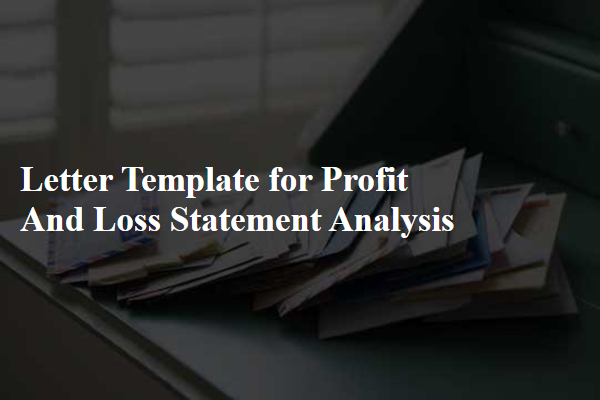Hey there! If you're diving into the intricate world of profit and loss statements, you're not alone. Analyzing these financial documents can seem daunting, but it's essential for understanding your business's financial health. We've got insights and tips lined up that will help you decode these numbers and make informed decisions for your growth. So, let's explore this togetherâread on for more expert guidance!

Introduction and Purpose
A profit and loss statement (also known as an income statement) is a crucial financial document for businesses, presenting a comprehensive overview of revenues and expenses over a specific accounting period. This analysis serves to assess the company's financial performance, highlighting key metrics such as gross profit, operating income, and net profit, which collectively shed light on the profitability and operational efficiency of the organization. Understanding these figures aids stakeholders, including investors and management, in identifying trends, making informed decisions about budgeting, resource allocation, and strategic planning while ensuring compliance with financial regulations. Such analysis can also compare performance against industry benchmarks, enhancing competitiveness in the marketplace.
Summary of Financial Performance
The analysis of the profit and loss statement reveals crucial insights into the financial performance of the company. Total revenue reached $1.2 million for the fiscal year 2023, reflecting a 15% increase compared to the prior year, driven primarily by new product launches and expanded market reach in North America. Cost of goods sold (COGS) amounted to $720,000, representing a 10% rise due to increased raw material prices and supply chain disruptions. As a result, the gross profit stands at $480,000, yielding a gross margin of 40%. Operating expenses, including marketing, salaries, and administration, totaled $300,000, which is a 5% increase attributed to heightened advertising efforts and workforce expansion. Consequently, operating income is recorded at $180,000, equivalent to a 15% operating margin. Net income, after accounting for taxes and interest, reaches $140,000, indicating a notable 12% return on sales and affirming the company's strong fiscal health amidst economic challenges.
Key Financial Metrics
A profit and loss statement analysis provides insight into key financial metrics that gauge a company's operational efficiency and profitability. The gross profit margin, calculated as a percentage of revenue, indicates how well a business converts sales into profits, typically ranging between 20% to 60% for various industries. Operating expenses, which include salaries, rent, and utilities, must be carefully monitored, ideally not exceeding 30% to 50% of total revenue for sustainable growth. Net profit margin, reflecting earnings after all expenses, is crucial for investors, with healthy margins usually above 10%. Revenue growth rate measures sales increase over a specific period, often benchmarked against industry averages, while EBITDA (Earnings Before Interest, Taxes, Depreciation, and Amortization) offers a clearer view of operational performance, commonly analyzed as a multiple of revenue. Understanding these key metrics helps stakeholders make informed decisions regarding business performance and future strategy.
Comparative Analysis
A comparative analysis of the profit and loss statement reveals significant trends in financial performance across multiple reporting periods, typically including quarterly or yearly data. Revenue growth, indicated by percentage increases or decreases, can provide insights into sales performance across sectors, such as product lines or geographic markets. Expenses, categorized into cost of goods sold (COGS) and operational costs, influence profit margins and can highlight potential areas for cost reduction. Net profit figures, calculated after deducting total expenses from total revenue, serve as a critical metric for assessing overall business profitability. Key Performance Indicators (KPIs), such as gross profit margin and operating margin ratios, offer a deeper understanding of operational efficiency and financial health. Stakeholder engagement through presentations incorporating data visualization tools can enhance comprehension of these financial insights, assisting in strategic decision-making and future planning. Financial statements, primarily analyzed through tools like horizontal and vertical analysis, shed light on trends, ensuring transparency and accountability in financial reporting.
Recommendations and Next Steps
Analyzing a profit and loss statement reveals key insights into a company's financial health. Revenue streams, such as sales from product lines or services, should be assessed for growth trends year-over-year. A focus on cost of goods sold (COGS) provides clarity on material expenses and manufacturing efficiency, particularly against industry benchmarks. Operating expenses, including overhead costs like rent and salaries, need scrutiny to identify potential areas for cost reduction. The net profit margin offers a snapshot of profitability, guiding strategic decisions for reinvestment or cost management. Recommendations for improving financial performance might include diversifying revenue sources, enhancing operational efficiencies, or renegotiating vendor contracts. Next steps involve setting specific financial targets, implementing tracking systems for performance metrics, and regularly revisiting the profit and loss statement to adjust strategies as necessary.













Comments